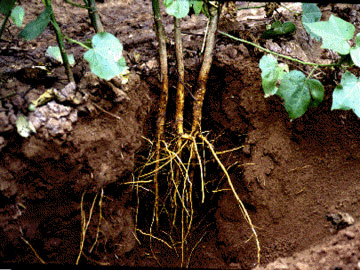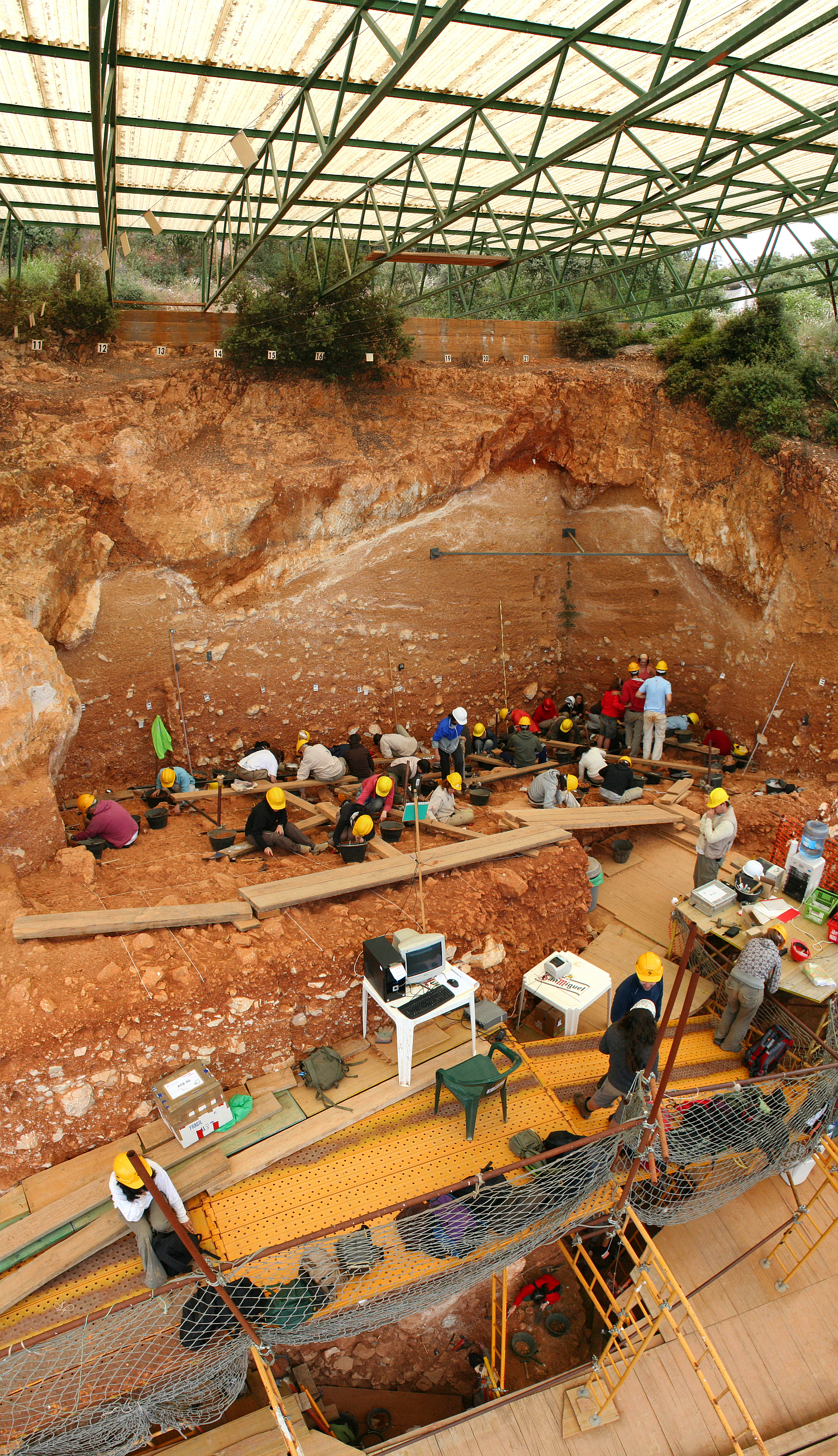|
Overburden
In mining, overburden (also called waste or spoil) is the material that lies above an area that lends itself to economical exploitation, such as the rock, soil, and ecosystem that lies above a coal seam or ore body. Overburden is distinct from tailings, the material that remains after economically valuable components have been extracted from the generally finely milled ore. Overburden is removed during surface mining, but is typically not contaminated with toxic components. Overburden may also be used to restore an exhausted mining site during reclamation. Interburden is material that lies between two areas of economic interest, such as the material separating coal seams within strata.Peng, Syd S. (1986) ''Coal Mine Ground Control'' (2nd edition), Wiley, New York, page 303, Analogous uses Overburden is also used for all soil and ancillary material above the bedrock horizon in a given area. By analogy, overburden is also used to describe the soil and other material that lies a ... [...More Info...] [...Related Items...] OR: [Wikipedia] [Google] [Baidu] |
Mining
Mining is the Resource extraction, extraction of valuable geological materials and minerals from the surface of the Earth. Mining is required to obtain most materials that cannot be grown through agriculture, agricultural processes, or feasibly created Chemical synthesis, artificially in a laboratory or factory. Ores recovered by mining include Metal#Extraction, metals, coal, oil shale, gemstones, limestone, chalk mining, chalk, dimension stone, rock salt, potash, gravel, and clay. The ore must be a rock or mineral that contains valuable constituent, can be extracted or mined and sold for profit. Mining in a wider sense includes extraction of any non-renewable resource such as petroleum, natural gas, or even fossil water, water. Modern mining processes involve prospecting for ore bodies, analysis of the profit potential of a proposed mine, extraction of the desired materials, and final mine reclamation, reclamation or restoration of the land after the mine is closed. Mining ma ... [...More Info...] [...Related Items...] OR: [Wikipedia] [Google] [Baidu] |
Spoil Tip
A spoil tip (also called a boney pile, culm bank, gob pile, waste tip or bing) is a pile built of accumulated ''spoil'' – waste material removed during mining. Spoil tips are not formed of slag, but in some areas, such as England and Wales, they are referred to as slag heaps. In Scotland the word ''bing'' is used. In North American English the term is mine dump or mine waste dump. The term "spoil" is also used to refer to material removed when digging a foundation, tunnel, or other large excavation. Such material may be ordinary soil and rocks (after Coal preparation plant, separation of coal from waste), or may be heavily contaminated with chemical waste, determining how it may be disposed of. Clean spoil may be used for land reclamation. Spoil is distinct from tailings, which is the processed material that remains after the valuable components have been extracted from ore. Etymology The phrase originates from the French word ''espoilelier'', a verb conveying the meanin ... [...More Info...] [...Related Items...] OR: [Wikipedia] [Google] [Baidu] |
Gangue
Gangue () is the commercially worthless material that surrounds, or is closely mixed with, a wanted mineral in an ore deposit. It is thus distinct from overburden, which is the waste rock or materials overlying an ore or mineral body that are displaced during mining without being processed, The separation of valuable mineral from gangue minerals is known as mineral processing, mineral dressing, or ore dressing. It is a necessary, and often significant, aspect of mining. It can be a complicated process, depending on the nature of the minerals involved. For example, galena, an ore of lead, is usually found in large pieces within its gangue, so it does not normally need extensive processing to remove it; but cassiterite, the chief ore mineral of tin, is usually disseminated as very small crystals throughout its gangue, so when it is Underground mining (hard rock), mined from hard rock, the ore-bearing rock first needs to be crushed very finely, and then has to be subjected to sophi ... [...More Info...] [...Related Items...] OR: [Wikipedia] [Google] [Baidu] |
Root
In vascular plants, the roots are the plant organ, organs of a plant that are modified to provide anchorage for the plant and take in water and nutrients into the plant body, which allows plants to grow taller and faster. They are most often below the surface of the soil, but roots can also be aerial root, aerial or aerating, that is, growing up above the ground or especially above water. Function The major functions of roots are absorption of water, plant nutrition and anchoring of the plant body to the ground. Types of Roots (major rooting system) Plants exhibit two main root system types: ''taproot'' and ''fibrous'', with variations like adventitious, aerial, and buttress roots, each serving specific functions. Taproot System Characterized by a single, main root growing vertically downward, with smaller lateral roots branching off. Examples. Dandelions, carrots, and many dicot plants. Fibrous RootSystem Consists of a network of thin, branching roots that spread out from ... [...More Info...] [...Related Items...] OR: [Wikipedia] [Google] [Baidu] |
Arboriculture
Arboriculture (, from ) is the cultivation, management, and study of individual trees, shrubs, vines, and other perennial woody plants. The science of arboriculture studies how these plants grow and respond to cultural practices and to their environment. The practice of arboriculture includes cultural techniques such as selection, planting, training, fertilizer, fertilization, pest and pathogen control, pruning, Tree shaping, shaping, and felling, removal. Overview A person who practices or studies arboriculture can be termed an ''arborist'' or an ''arboriculturist''. A ''tree surgeon'' is more typically someone who is trained in the physical maintenance and manipulation of trees and therefore more a part of the arboriculture process rather than an arborist. Risk management, legal issues, and aesthetic considerations have come to play prominent roles in the practice of arboriculture. Businesses often need to hire arboriculturists to complete "tree hazard surveys" and generally ... [...More Info...] [...Related Items...] OR: [Wikipedia] [Google] [Baidu] |
Cosmic Radiation
Cosmic rays or astroparticles are high-energy particles or clusters of particles (primarily represented by protons or atomic nuclei) that move through space at nearly the speed of light. They originate from the Sun, from outside of the Solar System in our own galaxy, and from distant galaxies. Upon impact with Earth's atmosphere, cosmic rays produce showers of secondary particles, some of which reach the surface, although the bulk are deflected off into space by the magnetosphere or the heliosphere. Cosmic rays were discovered by Victor Hess in 1912 in balloon experiments, for which he was awarded the 1936 Nobel Prize in Physics. Direct measurement of cosmic rays, especially at lower energies, has been possible since the launch of the first satellites in the late 1950s. Particle detectors similar to those used in nuclear and high-energy physics are used on satellites and space probes for research into cosmic rays. Data from the Fermi Space Telescope (2013) have been ... [...More Info...] [...Related Items...] OR: [Wikipedia] [Google] [Baidu] |
Particle Physics
Particle physics or high-energy physics is the study of Elementary particle, fundamental particles and fundamental interaction, forces that constitute matter and radiation. The field also studies combinations of elementary particles up to the scale of protons and neutrons, while the study of combinations of protons and neutrons is called nuclear physics. The fundamental particles in the universe are classified in the Standard Model as fermions (matter particles) and bosons (force-carrying particles). There are three Generation (particle physics), generations of fermions, although ordinary matter is made only from the first fermion generation. The first generation consists of Up quark, up and down quarks which form protons and neutrons, and electrons and electron neutrinos. The three fundamental interactions known to be mediated by bosons are electromagnetism, the weak interaction, and the strong interaction. Quark, Quarks cannot exist on their own but form hadrons. Hadrons that ... [...More Info...] [...Related Items...] OR: [Wikipedia] [Google] [Baidu] |
Archeological
Archaeology or archeology is the study of human activity through the recovery and analysis of material culture. The archaeological record consists of artifacts, architecture, biofacts or ecofacts, sites, and cultural landscapes. Archaeology can be considered both a social science and a branch of the humanities. It is usually considered an independent academic discipline, but may also be classified as part of anthropology (in North America – the four-field approach), history or geography. The discipline involves surveying, excavation, and eventually analysis of data collected, to learn more about the past. In broad scope, archaeology relies on cross-disciplinary research. Archaeologists study human prehistory and history, from the development of the first stone tools at Lomekwi in East Africa 3.3 million years ago up until recent decades. Archaeology is distinct from palaeontology, which is the study of fossil remains. Archaeology is particularly important for learni ... [...More Info...] [...Related Items...] OR: [Wikipedia] [Google] [Baidu] |
Excavation (archaeology)
In archaeology, excavation is the exposure, processing and recording of archaeological remains. An excavation site or "dig" is the area being studied. These locations range from one to several areas at a time during a project and can be conducted over a few weeks to several years. Excavation involves the recovery of several types of data from a site. This data includes artifacts (portable objects made or modified by humans), features (non-portable modifications to the site itself such as post molds, burials, and hearths), ecofacts (evidence of human activity through organic remains such as animal bones, pollen, or charcoal), and archaeological context (relationships among the other types of data).Kelly&Thomas (2011). ''Archaeology: down to earth'' (4th ed.). Belmont, Calif.: Wadsworth, Cengage Learning. Before excavating, the presence or absence of archaeological remains can often be suggested by, non-intrusive remote sensing, such as ground-penetrating radar. Basic inf ... [...More Info...] [...Related Items...] OR: [Wikipedia] [Google] [Baidu] |
Astrobleme
An impact structure is a generally circular or craterlike geologic structure of deformed bedrock or sediment produced by impact on a planetary surface, whatever the stage of erosion of the structure. In contrast, an impact crater is the surface expression of an impact structure. In many cases, on Earth, the impact crater has been destroyed by erosion, leaving only the deformed rock or sediment of the impact structure behind.Neuendorf, K.K.E., J.P. Mehl Jr., and J.A. Jackson, eds. (2005) ''Glossary of Geology'' (5th ed.). Alexandria, Virginia, American Geological Institute. 779 pp. This is the fate of almost all old impact craters on Earth, unlike the ancient pristine craters preserved on the Moon and other geologically inactive rocky bodies with old surfaces in the Solar System. Impact structure is synonymous with the less commonly used term astrobleme meaning "star wound". In an impact structure, the typical visible and topographic expressions of an impact crater are no lo ... [...More Info...] [...Related Items...] OR: [Wikipedia] [Google] [Baidu] |
Geologic Feature
Geology (). is a branch of natural science concerned with the Earth and other astronomical objects, the rocks of which they are composed, and the processes by which they change over time. Modern geology significantly overlaps all other Earth sciences, including hydrology. It is integrated with Earth system science and planetary science. Geology describes the structure of the Earth on and beneath its surface and the processes that have shaped that structure. Geologists study the mineralogical composition of rocks in order to get insight into their history of formation. Geology determines the relative ages of rocks found at a given location; geochemistry (a branch of geology) determines their absolute ages. By combining various petrological, crystallographic, and paleontological tools, geologists are able to chronicle the geological history of the Earth as a whole. One aspect is to demonstrate the age of the Earth. Geology provides evidence for plate tectonics, the evolutionary ... [...More Info...] [...Related Items...] OR: [Wikipedia] [Google] [Baidu] |





